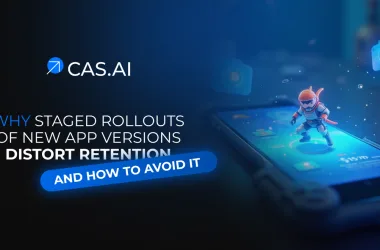Kids Mobile Games in 2025 operate in a tougher, more opaque market than a few years ago. For years, many kids developers lived on organic installs, but since late-COVID and through 2022–2024 the rules changed: discovery became volatile, “Similar Apps” exposure turned opaque, and cross-promotion lost reliability. Teams building a kids app want to know what still moves the needle—and how to measure it. Key thesis: In kids’ mobile games, engagement quality (not just retention snapshots) is the clearest leading indicator for long-term organic—especially on iOS. On Google Play, “Similar Apps” can make or break a title’s trajectory, but access to it has become inconsistent.
A Short History of the Kids Mobile Games Market
- 2008–2011: The Wild West. Few devices, almost no kids content. Anything shipped could get traction because supply lagged demand.
- 2012–2016: Android Gold Rush. Device growth outpaced the app market. Even simple kids apps received organic + ad revenue.
- 2017–2018: Rules & Quality Era (Android). Clearer platform expectations: stability (no ANRs), engagement, and content depth.
- 2020–2021: COVID Spike. Many Kids Mobile Games hit huge organic peaks (20k–200k/day).
- 2022–2024: Post-COVID Uncertainty. Organic visibility—especially via Similar Apps—became erratic; Android felt algorithmic and opaque.
Takeaway: Expect less determinism from Android organic than in 2017–2018, and anchor strategy on fundamentals you control: engagement, UX, and honest ad flows.
1) The “Similar Apps” Problem (Google Play) for Kids Apps
“Similar Apps” historically drives a majority of organic for many kids mobile games. Landing there can push installs to 10k+/day (sometimes 20–60k+); missing it can leave you at ≤1–2k/day.
What changed
- Since ~2021, inclusion is less predictable; cross-promo “seeding” is weaker.
- Publisher support replies often cite generic issues that don’t map to reality.
- Play Console blurs “Search” vs “Explore”: non-brand discovery is harder to attribute.
Working assumptions
- Recommendation rails lean on ML signals: engagement quality, user satisfaction, and “fit.”
- Low-intent cross-promo can depress perceived quality.
Actionable steps
- Treat Similar Apps as a bonus, not the plan; make a model that works without it.
- Filter cross-promo for higher intent (see §4); avoid indiscriminate pushes.
2) iOS vs Android: Different Levers for Kids Mobile Games
iOS: Closer to Android’s 2017–2018 “quality bar.” Monthly engagement strongly correlates with downloads.
Android (Google Play): Discovery is opaque; engagement matters, but exposure depends on recommendation rails.
Practical metric (kids)
- Track Monthly Engagement per User (28-day playtime/user). Titles with 1–10+ hours/month sustain visibility on iOS.
- Don’t over-weight D1/D7 snapshots; kids usage is bursty and family-mediated.
3) Engagement Is the Leading Indicator in Kids Mobile Games
Top iOS titles by monthly engagement are also top downloaders. On Android, engagement won’t guarantee Similar Apps—but it protects KPIs and monetization when discovery fluctuates.
- Instrument ASL, sessions/MAU, 28-day playtime/user, re-engagement triggers.
- Optimize first-session clarity (parents + kids), stable difficulty, and kid-safe ad cadence (cached rewarded, no surprises).
4) Cross-Promotion Isn’t Dead—It Needs Intent for Kids Apps
Blunt “Click the big red button → Store page” flows yield low CVR and weak post-install engagement. Build intent before the store:
- Playable ads / mini-demos (10–15s of true core loop).
- Ethical “mock store page” gates (A/B) to pre-qualify motivated users.
- Content matching (coloring → drawing; puzzles → logic; racer → runner).
- Geo/device filters to avoid diluting engagement signals.
Outcome: With high intent, install CVR rises and post-install engagement can outperform organic by +5–10%, but there’s no guaranteed organic lift on Google Play.
5) Creative & Store Research: What Parents Do Before Installing a Kids App
- Parents scroll more screenshots than expected; watch videos; skim descriptions; read reviews.
- ASO tips: First two screenshots = safety + fun + learning; readable captions; 15–30s video of core loop; localize for top geos and parental norms.
6) Known Shocks & Platform Oddities in Kids Mobile Games
- 2018–2019 “Siberian Apocalypse” (year-long Similar Apps disappearance/return for some teams).
- COVID surges followed by drops.
- Policy/Data Safety rounds not always correlate with organic outcomes.
Lesson: Don’t overfit to temporary behavior. Build resilience: engagement-first design, diversified UA, sustainable monetization.
7) What to Measure in the Kids Category (Kids Apps)
- Engagement: 28-day playtime/user, ASL, sessions/MAU.
- Retention: D1/D7/D30 (interpret with care).
- Store funnel: CTR to store, install CVR, video play rate, screenshot dwell time.
- Quality signals: crash rate, ANR, cold start, ad error rate, % cached rewarded.
- UA economics: CPI, ROAS (D0/D7), eCPM, fill rate, revenue/1000 sessions.
8) Playbook: What to Do Now for Kids Mobile Games
- Design for monthly engagement (1–10+ hours/user/month with episodic content, gentle progression, parent-approved rewards).
- Kid-safe ad strategy: rewarded > interstitial; show at clean pauses; cache before prompt; no banner UI overlap.
- Rebuild cross-promo as an intent engine (playables, content matching, geo/device filters).
- ASO for parents: lead with age, safety, what the kid learns/does, and an instantly legible core loop.
- Don’t plan around Similar Apps; model growth without it and scale gracefully if it hits.
- Instrument & iterate weekly across geo × device × source; kill tactics that depress engagement.
- Use iOS as a baseline for product/ASO truths if Android organic is unstable.
Closing Thought
Kids games moved from predictable organic to opaque, ML-driven discovery. You can’t control the algorithms; you can control engagement, intent, and clean ad/store flows. Build for monthly playtime, prove value before the store, measure hard—and your portfolio will ride out turbulence and grow when the algorithms line up. Got data but no next step? Ping the CAS team—we’ll map the plan.
Helpful resources
![]()




